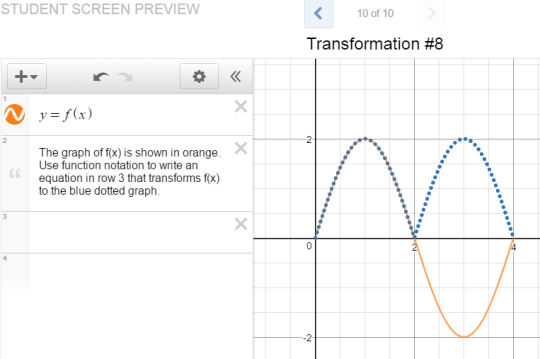We asked the Desmos Fellows to give
this classic transformations activity
an upgrade by adding one screen. The Fellows blended student background
knowledge, goals for learning, and
design principles
to create
these screens
to enhance the original activity.
Reverse the Direction
-
The original activity gives students a graph and asks them to generate a
function. After practicing this skill,
Bob Lochel and
Anna Scholl like to see if
students can go in the reverse direction by asking them to generate a sketch
given a function. Asking students to describe their process allows teachers
to see if students can decompose a function transformation into stages.
Delay Feedback for Reflection
- Paul Jorgens noticed that a student could complete most of the screens by guessing and checking answers. He added a cart sort so that students would have a chance to do some reasoning after the initial exploration.
-
Sarah Blick Vandivort suggests
adding a screen where students can predict what a function will look like
using words and a sketch, before having the chance to check their thinking.
Similarly, Scott Miller asks
students to explain their reasoning for the composition of transformations
of f(x). Analysis of responses allows the teacher to see what level of
understanding, vocabulary and connections students are making.
Opportunities to be Right and Wrong in Different, Interesting Ways
-
Linda Saeta added a screen that
asked students for a second way to match a transformed graph. This flexible
thinking about transformations and the ability to recognize them in a graph
helps students with some of the problems they’ll encounter in Calculus, so
having students look for them in earlier classes is good practice.
-
Nick Corley asked students to
create their own function similar to the ones encountered in previous
screens, and to predict what the graph would look like before having a
chance to check their thinking. This type of screen also offers a way to
provide closure on the activity. Teachers can select several student
generated functions to compare in words, with the teacher revealing each
graph after students have had the opportunity to discuss similarities and
differences.
-
Shelley Carranza asked students
to transform f(x) so that it would go through a given point. Using the
dashboard to share solutions and ask questions such as “Which of these
graphs used the MOST transformation types to go through the blue point and
how do you know?” can make for rich conversation and formative
assessment.
Extensions
- Meg Craig added the screen below to provide an additional challenge for Precalculus or Algebra II students. This challenges students to make connections to other function types (absolute value) and also brings up function composition, offering students the chance to think about what happens if we reverse the composition order of the solution.
-
Patty Stephens expanded on
this idea and asked students to explore f(abs(x)).

What are some other ways we can upgrade this or other practice activities? Let us know on Twitter @desmos.
